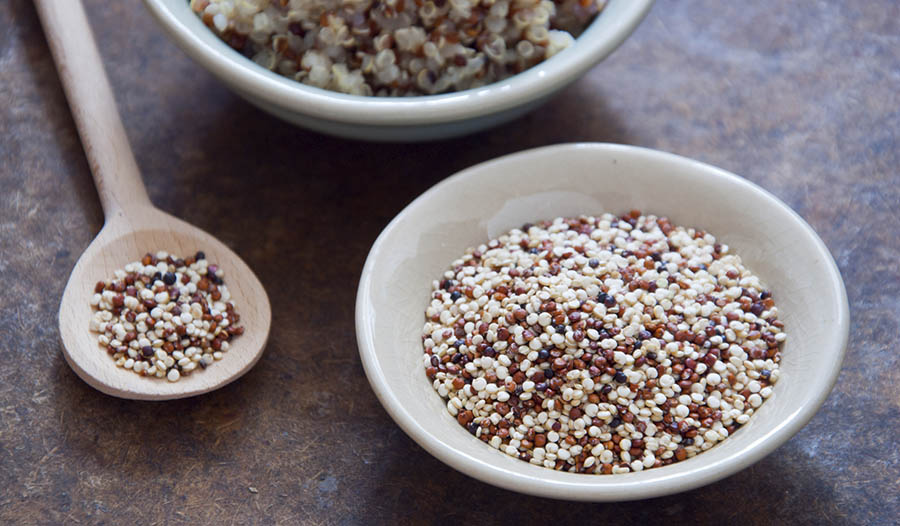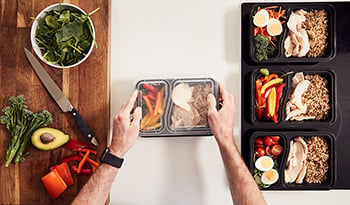What Makes SuperFoods So Super?

Learn about the qualities that make superfoods great.
"Superfood" is a non-scientific term for a natural and unprocessed food that is exceptionally rich in antioxidants and other nutrients. Common and well-known examples of superfoods include blueberries, various nuts, and dark greens like kale. Some beverages like green tea also qualify as superfoods. There are many recipes that use superfoods to give you a boost of antioxidants.
Quinoa
Quinoa is a small, grain-like seed and one of the few seeds or grains to contain all nine essential amino acids that the human body needs. It is also loaded with protein; a single cup contains 8 grams of protein.
Quinoa has a texture that resembles that of couscous or rice and a nutty and mild flavor. It is also easy to work with. Quinoa can be used in cereals, soups, salads and many other items. Since quinoa has a protective coating called saponin that has a bitter taste, it should be rinsed before being used. It can then be toasted in oil or boiled. When quinoa is fully cooked, it pops open, revealing the kernel's germ. The ratio of boiled quinoa is 2 cups of liquid to 1 cup of quinoa.
Pear and Quinoa Salad
Ingredients:
- 1 cup quinoa
- 2 ripe but firm pears, diced
- 2 tablespoons canola oil or walnut oil
- 1 tablespoon fruity vinegar like pear, pomegranate or raspberry
- ¼ teaspoon ground pepper
- ¼ teaspoon salt
- ¼ cup snipped fresh chives
- ½ cup toasted and coarsely chopped pecans or walnuts
Instructions:
- Boil 2 cups of water in a big saucepan and lower to a simmer. Stir in the quinoa, cover it and cook it until the quinoa has popped, which typically takes 15 minutes.
- Add the vinegar, oil, salt, pepper and chives to a large bowl and stir with a whisk. Then, stir in the pears until they are coated with the mixture.
- Drain the quinoa and add it to the salad. Toss it to combine. Either cool the salad in the refrigerator for 15 minutes or serve it warm. Top it with the nuts before serving.
Chia Seeds
Chia seeds come from a desert plant called Salvia hispanica that is related to mint. They were a staple of Mayan and Aztec diets and are the seeds used in the popular Chia Pets. Chia seeds contain more fatty acids than any other known plant, and they have more antioxidants than even blueberries. They are also loaded with other nutrients like potassium, magnesium, calcium, and iron. Chia seeds are basically tasteless and can thus be used in many recipes.
Chia Seed Pudding
Ingredients:
- ¼ cup chia seeds
- 1 cup vanilla-flavored almond milk
- 1 cup plain Greek yogurt
- 2 tablespoons pure maple syrup
- 1/8 teaspoon Kosher salt
- 1 teaspoon pure vanilla extract
- ¼ cup sliced toasted almonds
- 1 pint chopped and hulled strawberries
Instructions:
- Add the almond milk, yogurt, 2 tablespoons of maple syrup, vanilla extract, and salt to a medium bowl and stir with a whisk. Add the chia seeds and stir.
- Let the pudding sit for 30 minutes, and then stir again if the chia seeds have all sunk to the bottom. Cover the pudding and leave it in the refrigerator overnight.
- The next day, mix the strawberries and nuts with an additional 4 teaspoons of maple syrup; the strawberry mixture will be a topping for the pudding. The recipe makes four servings.
Oatmeal
Oatmeal is made from oat grains and has long been a breakfast staple. Typically served hot, oatmeal is a good food for a cold day. It is also loaded with fiber and can thus help lower cholesterol and the associated risk of heart disease. A single bowl contains 4 grams of fiber, which also helps digestion. Oatmeal also contains a lot of antioxidants, minerals, and vitamins.
There are many ways to jazz up a bowl of oatmeal. Some other superfoods, like blueberries or almonds, can make excellent toppings.
Green Tea
Unlike other types of tea, green tea is made by steeping the unfermented leaves of the tea plant, Camellia sinensis, in hot water. Green tea has more antioxidants than other types of tea. Green tea contains phytochemicals, including one called Epigallocatechin gallate that slows the growth of abnormal cells and thus may prevent some cancers. Two or three cups a day are recommended for the maximum health benefits.
Matcha tea is a type of green tea made from the powdered tea leaves. Since people actually drink the powdered leaves, it provides even more health benefits than ordinary green tea. Matcha is traditionally stirred with a bamboo brush until it develops froth. Matcha has a strong taste that some have compared to spinach or grass, but it can be sweetened.
Pistachios
Pistachios are nuts thought to have been part of the human diet since prehistoric times. They grow on trees and have a hard shell that can be cracked open. They are cholesterol-free and can help keep cholesterol levels under control. Pistachios contain a lot of protein and fiber, and they have about as much potassium as a small banana. A single serving consists of about 45 nuts that can be added to a salad. Pistachios also make a portable and healthy snack.
Almonds
Almonds are the most nutritionally dense nut, which means that every ounce contains more nutrients per calorie than any other nut. A single ounce contains 191 calories and 3.4 grams of fiber, which is about 14 percent of the daily recommended amount. That same ounce also provides a lot of calcium, iron, magnesium, potassium, and vitamin E. Almonds can be eaten raw, but dry roasted nuts are easier to digest. Like pistachios, they are easy to carry and can be eaten anywhere and anytime.
Blueberries
Blueberries are one of the better-known superfoods. A single cup of blueberries contains 84 calories, about 24 percent of the recommended daily allowance of vitamin C, and about 14 percent of the recommended daily allowance of fiber. Blueberries also contain a lot of antioxidants that can help reduce blood pressure and may also boost metabolism. Blueberries can be eaten fresh, frozen, or dried. The freshest locally produced berries will generally be available from May to October.
Beets
Beets are root vegetables that owe their purple color to antioxidants called betalains. Beets are also good sources of fiber, potassium, vitamins A and C, and some of the vitamin B complex. They are an especially good source of vitamin B9 or folate, which helps prevent neural tube defects in developing babies. A single cup of beets contains 58 calories. Beets can be eaten raw or cooked, or they can be drunk as a juice. Powdered beets can be used to make smoothies or shakes.
Lentils
Lentils are a legume, so they are in the same family as peanuts, beans, peas, and carob. They are loaded with protein, fiber, antioxidants, folate, potassium, and iron. Lentils are particularly good for vegans and vegetarians because they contain more protein than a same-sized portion of beef. Their high iron content can help prevent some types of anemia. Unlike many other foods, lentils don't lose their nutritional value after being cooked; in fact, cooking lentils makes it easier for people to absorb their nutrients. Lentils are also cheap and versatile; they can be used as a side dish or added to soup, chili, or other recipes.
Kale
Kale is a leafy green vegetable related to broccoli that boasts more antioxidants than any other fruit or vegetable. A single cup of boiled kale has only 36 calories, but it is rich in vitamin A, vitamin C, vitamin K, calcium, iron, and fiber. There are many varieties of kale, but most of them have tough leaves. Consequently, many people prefer to cook kale. It can be made into chips or powder, and the latter can be added to smoothies.
Sesame Roasted Kale
Ingredients:
- 17.6 oz. kale
- 1 tablespoon sesame seeds
- 1 tablespoon olive oil
- 2 teaspoons sesame oil
Instructions:
- Preheat the oven to 425 degrees Fahrenheit.
- Rinse the kale and then dry it, preferably in a salad spinner. Cut out the center stalks and slice the kale into pieces 2 inches long.
- Put the kale on a baking tray and drizzle the sesame and olive oils over it. Scatter the sesame seeds over the kale and then season it with black pepper and sea salt. Roast the kale for 20 minutes and turn it over halfway through. Cook it until the edges are crisp.
Garlic
Garlic is a bulb that has been used as both food and medicine for centuries. Three cloves of garlic contain only 13 calories. It contains many antioxidants along with manganese and vitamins C and B6. Garlic is also a prebiotic and may therefore aid digestion. Garlic cloves can be made into powders or extracts. It can be used to season many dishes, such as soups, meats, and salad dressings.
Garlic Vinaigrette Dressing
Ingredients:
- 3 crushed garlic cloves
- 1 ½ cups olive oil
- ¼ cup rice vinegar
- ½ teaspoon mixed Italian herbs
- 2 teaspoons golden syrup or sugar
- 1 pinch pepper
- 1 pinch salt
Instructions:
- Put all the ingredients into a jar with a lid and shake until everything has blended together.
- Let the dressing cool in the fridge for at least an hour before using.
Ginger
Ginger or ginger root is the underground stem of a plant called Zingiber officinale, and it has been used in food and medicine for centuries. It can be eaten raw or dried, and it is often used as a spice. Ginger can also be made into drinks like ginger tea or ginger ale.
It contains a lot of antioxidants. Ginger reduces inflammation by inhibiting the enzymes responsible. Small doses of ginger can relieve different types of nausea, including those caused by morning sickness and chemotherapy.
Click here to check out all the SuperFood Products that iHerb carries!
References:
- Morin, K.; 25 Greatist Superfoods and Why They're Super; Greatist Website; Accessed 03/16/17
- Group, Dr. E; What Is A Superfood?; Global Healing Center Website; Accessed 03/16/17
- McKenna, E.; How to Cook Quinoa; Eating Well Website; Accessed 03/16/17
- Staff; Pear-Quinoa Salad; Eating Well Website; Accessed 03/16/17
- De Laurentiis, G.; Chia Seed Pudding; Food Network Website; Accessed 03/16/17
- Sass, C.; 7 Things You Should Know About Matcha; Health Website; Accessed 03/16/17
- Oliver, J.; Sesame-Roasted Kale; Jamie Oliver Website; Accessed 03/16/17
- Chunkeebeef; Garlic Vinaigrette Dressing; Food Website; Accessed 03/16/17
DISCLAIMER:This Wellness Hub does not intend to provide diagnosis...












































































 Table of Contents
Table of Contents

















